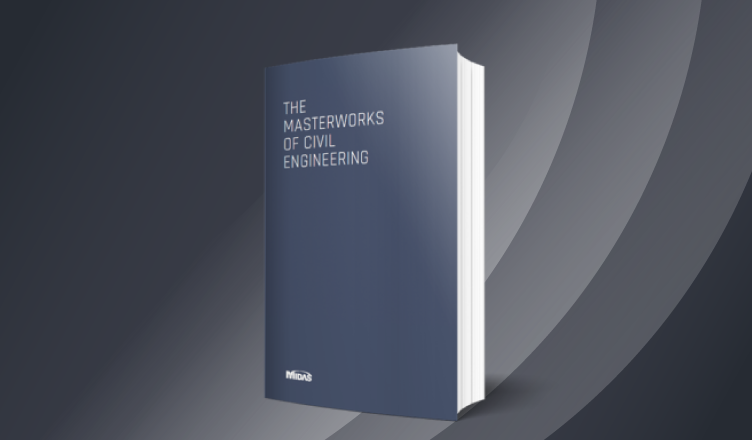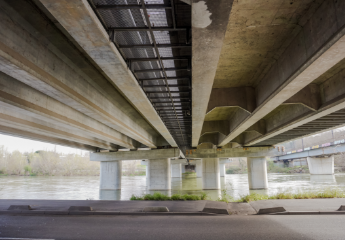The Andy Warhol Bridge is an eyebar-chain, self-anchored suspension bridge carrying Seventh Street over the Allegheny River in the city of Pittsburgh, PA. This bridge is one of the "Three Sisters" bridges constructed from 1924 to 1928 which comprise the only trio of identical, side-by-side bridges in the world and the first self-anchored bridges constructed in the United States.
Scheduled for rehabilitation in 2016 through 2017, the bridge was modeled in 3D in midas Civil to evaluate global effects of transverse live load distribution, determine allowable procedure for deck removal and replacement, identify structural steel repairs, and evaluate the bridge for a condition where pedestrians are the only live load. This was accomplished in addition to providing verification of the forces within the unique system of a self-anchored suspension bridge.
This case study highlights:
1. Self-Anchored Suspension Bridge Mechanics
The session will show the mechanics of self-anchored suspension bridges comparing of traditional suspension bridges. We will see some theories of suspension bridges, considerations, and etc..
2. Create Finite Element Model for SASB for various purposes
We will see how to create an element model of suspension bridges with midas Civil. Let's go through the modeling process for suspension bridges.
3. Results & Verification (Expectation vs. Reality)
Lastly, we will compare between expectations and reality with results of midas Civil, the plan sheet forces, and the elastic theory.
Project Information
- Located in Pittsburgh, PA over Allegheny River
- Second bridge at this site
- Replaced 1884 Gustav Lindenthal suspension bridge
- Mandated by 1889 River and Harbor Act
- First self-anchored suspension bridge in U.S.
- Constructed by American Bridge Co. and Foundation Co. of NY
- First of the “Three Sisters” constructed from 1924-1928
/Self-Anchored%20Suspension%20Bridge%20Design/New%20images%20Self-Anchored%20Suspension%20Bridge%20Design/Andy%20Warhol%20Bridge%20project%20information.png?width=733&name=Andy%20Warhol%20Bridge%20project%20information.png)
1. Self-Anchored Suspension Bridge Mechanics
-
Need for end anchorages eliminated
-
Reduces right-of-way required
-
Girder sized for compression & flexure
-
Analysis by the elastic theory as an independent check
-
Deflection theory of suspension bridges also applicable, may be reduced to elastic theory
-
Special considerations for live load analysis
/Self-Anchored%20Suspension%20Bridge%20Design/New%20images%20Self-Anchored%20Suspension%20Bridge%20Design/Overview%20of%20the%20Traditional%20vs.%20Self-Anchored%20Suspension%20Bridges.png?width=734&name=Overview%20of%20the%20Traditional%20vs.%20Self-Anchored%20Suspension%20Bridges.png)
Fig. Overview of the Traditional vs. Self-Anchored Suspension Bridges
2. Create Finite Element Model for SASB for various purposes
A. A series of models are created for different purposes
-
Geometry
-
Initial Force System
-
Loading & Boundary Conditions
-
New Dead Loads
-
Moving & Static Live Loads
-
Construction Staging (Deck Removal & Pouring Sequences)
-
Pedestrians-Only Load Case
/Self-Anchored%20Suspension%20Bridge%20Design/New%20images%20Self-Anchored%20Suspension%20Bridge%20Design/A%20series%20of%20models%20are%20created%20for%20different%20purposes.png?width=733&name=A%20series%20of%20models%20are%20created%20for%20different%20purposes.png)
B. FEA Modeling Process
a) The initial model is created using the Suspension Bridge Wizard of midas Civil. However, the Suspension Bridge Wizard creates the normal (externally-anchored) suspension bridge model. Therefore, further modifications were made to convert the model to be self-anchored.
/Self-Anchored%20Suspension%20Bridge%20Design/New%20images%20Self-Anchored%20Suspension%20Bridge%20Design/FEA%20Modeling%20Process.png?width=734&name=FEA%20Modeling%20Process.png)
b) Manual modifications are made in order to reflect the self-anchorage system. The Post-Wizard Modifications are:
- Replace end boundary conditions
- Insert floor system (floor beams and stringers)
- Insert rigid links at girder/chain ends
- Modify Suspension Bridge Analysis Control
/Self-Anchored%20Suspension%20Bridge%20Design/New%20images%20Self-Anchored%20Suspension%20Bridge%20Design/5.png?width=733&name=5.png)
c) Additional Studies and FEA modeling are done for the study of the following issues:
- Moving & Static Live Loads
- Construction Staging (Deck Removal & Pouring Sequences)
- Pedestrians-Only Load Case
/Self-Anchored%20Suspension%20Bridge%20Design/New%20images%20Self-Anchored%20Suspension%20Bridge%20Design/6.png?width=735&name=6.png)
3. Results & Verification (Expectations vs. Reality)
The expectations such as below:
- Elastic Theory will give larger dead load forces
- Stiffening girder end moments same sign
- Stiffening girder DL moments same order of magnitude
For reality, the plan sheet forces, the elastic theory, and MIDAS results are compared:
/Self-Anchored%20Suspension%20Bridge%20Design/New%20images%20Self-Anchored%20Suspension%20Bridge%20Design/Results%20%26%20Verification%20(Expectations%20vs.%20Reality).png?width=732&name=Results%20%26%20Verification%20(Expectations%20vs.%20Reality).png)
Watch the full webinar video
 Get Started midas Civil
Get Started midas Civil
 Featured blog of this week
Featured blog of this week









